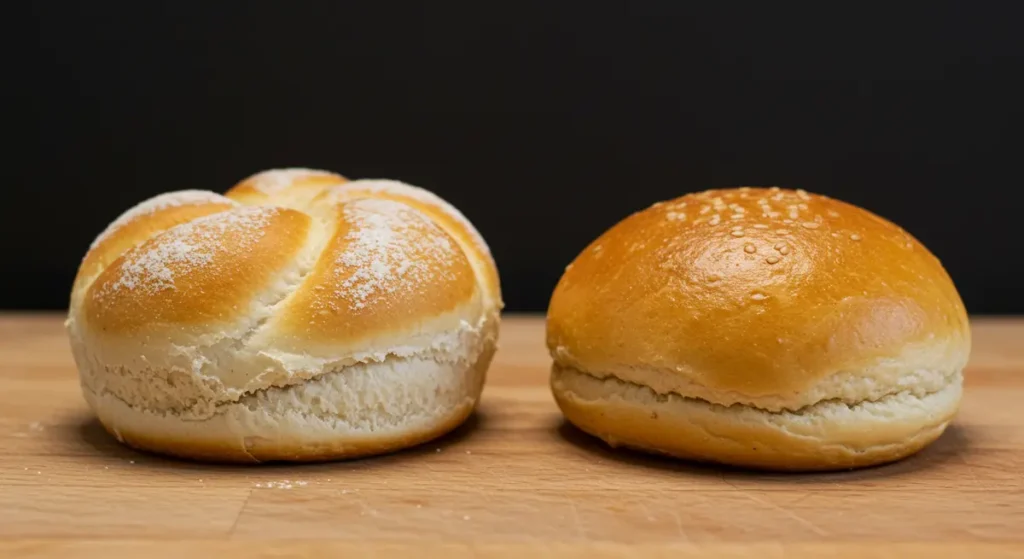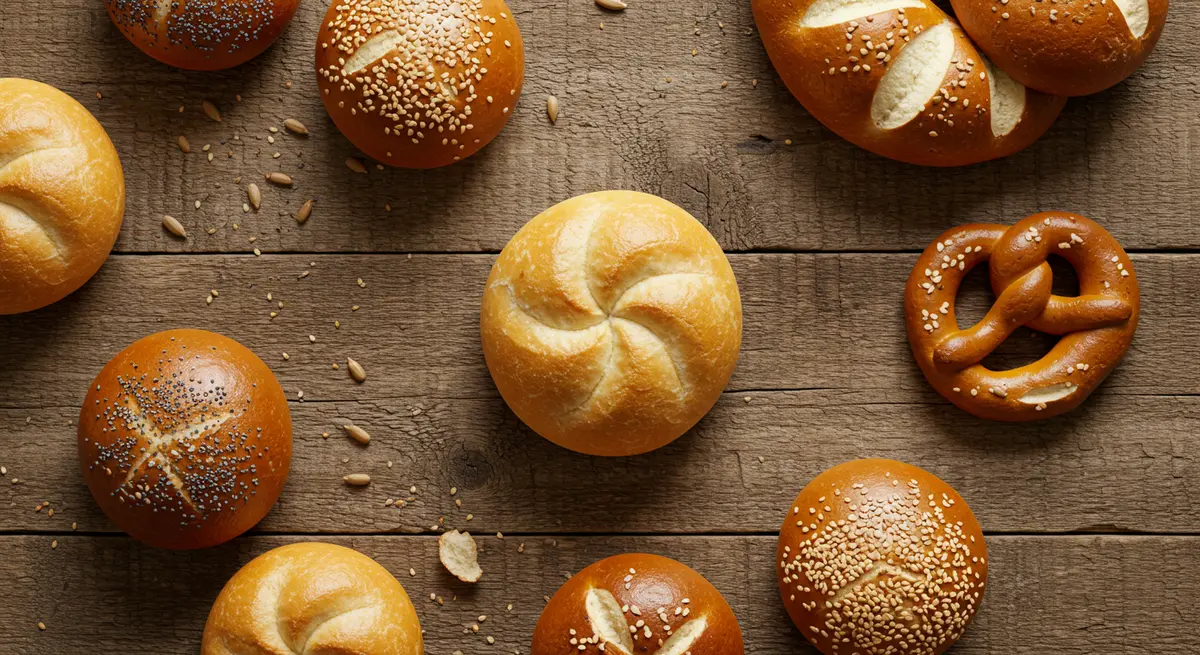What is the difference between a kaiser roll and a bun? This article explores these two popular bread options. Learn their unique characteristics and uses. Discover how they differ in shape, texture, and history.
What is the Difference Between a Kaiser Roll and a Bun?: An Overview
The question, what is the difference between a kaiser roll and a bun, often arises when choosing bread. They are both baked goods, yet they have distinct traits. Understanding these differences can greatly impact your meal. Therefore, it is important to learn about them.
Understanding the Kaiser Roll
What is the Difference Between a Kaiser Roll and a Bun? – The Kaiser’s Texture
Firstly, the kaiser roll is known for its crisp crust and airy interior. Kaiser rolls, sometimes called Vienna rolls, usually feature a five-petal swirl design. This makes them easily recognizable. Furthermore, their texture is important. They provide a sturdy base for fillings. Therefore, they are ideal for sandwiches.
The History Behind the Kaiser
In addition, the kaiser roll has a rich history. These rolls originate from Austria. Additionally, they are traditionally made with simple ingredients. Hence, their straightforward flavor complements many dishes. Moreover, the “kaiser” name means “emperor” in German. This implies a roll fit for royalty.
Culinary Uses of the Kaiser Roll
Kaiser rolls are incredibly versatile. For instance, they are often used for breakfast sandwiches. Similarly, they also work well for burgers. Furthermore, their firm texture holds up well to sauces. Consequently, they do not get soggy easily.
Exploring the World of Buns
The Characteristics of a Bun
A bun is more broadly defined, and there are several varieties. However, generally, a bun is softer and round. Indeed, it tends to have a smoother, less defined crust than a kaiser roll. Therefore, their soft texture makes them ideal for different purposes.
Buns’ Versatility
Buns are extremely flexible. Accordingly, they come in various shapes and sizes. They are used for hamburgers, hot dogs, and even sweet treats. In addition, they are designed to be easy to handle. Thus, they are perfect for casual eating.
Different Types of Buns
- Hamburger Buns: These are typically round and soft.
- Hot Dog Buns: These are longer and often have a top-sliced opening.
- Brioche Buns: Another variety, these are rich and buttery.
- Slider Buns: These are smaller, perfect for miniature burgers.
What is the Difference Between a Kaiser Roll and a Bun?: Key Differences

The Visual Contrast
- Kaiser Roll: Distinctive five-petal swirl, often crusty.
- Bun: Typically smooth and round, usually softer.
- Shape: This is a primary visual difference.
- Kaiser rolls often have an intentional design.
- Buns usually have a more simplistic form.
Texture Comparison: What is the Difference Between a Kaiser Roll and a Bun?
- Kaiser Roll: Crusty exterior with an airy interior.
- Bun: Softer texture throughout.
- The difference in texture affects the eating experience. However, it also matters how they interact with fillings. Therefore, choose based on the desired outcome.
Baking Techniques
The baking process for each also differs. Furthermore, kaiser rolls typically involve a specific technique to achieve their shape. Additionally, this baking technique results in its unique texture. Comparatively, buns often have simpler baking methods. Consequently, they have a softer crumb.
How the Differences Impact Usage
Best Uses for Kaiser Rolls
Kaiser rolls are great for heartier sandwiches. Specifically, they work well with fillings that may make softer bread soggy. Moreover, they provide a firm base. Ultimately, this maintains the structural integrity of the sandwich. They are excellent for:
- Large, loaded sandwiches.
- Breakfast sandwiches.
- Hearty burgers.
Best Uses for Buns
Buns are preferred for softer fillings. For example, they are perfect for traditional hamburgers or hot dogs. Also, they are better suited for dishes where a softer bite is desired. They are ideal for:
- Classic hamburgers.
- Hot dogs.
- Sliders.
- Sweet treats, such as some breakfast rolls.
What is the Difference Between a Kaiser Roll and a Bun? The Taste
Kaiser Roll Flavor
Kaiser rolls generally have a neutral flavor with a slight tang. Especially, this makes them compatible with various fillings. Indeed, their slightly crusty texture also adds to their appeal. However, the flavor is not overpowering.
Bun Flavor
Buns, on the other hand, can vary greatly in taste. For instance, brioche buns are sweeter and richer. Whereas, basic hamburger buns are mild. In general, the bun’s taste is not as prominent as the filling.
Recipe Considerations
When making your own bread, understanding these differences is important. Because, they require different ingredient ratios and methods. Thus, if you want to make a kaiser roll then research that specifically. Also, the same applies if you wish to make buns.
Kaiser Roll Recipe Tips
- Focus on developing a strong gluten network.
- Use a slightly longer proofing time for an airy interior.
- Ensure the oven is hot for a crisp crust.
Bun Recipe Tips
- Use softer flours for a tender crumb.
- Additionally, include fat, like butter, for a softer texture.
- Do not overwork the dough.
What is the Difference Between a Kaiser Roll and a Bun? – Making the Right Choice
Factors to Consider
- Filling: Therefore, consider whether the filling is wet or dry.
- Texture Preference: Decide if you want a crusty or soft bite.
- Dish Type: Specifically, consider if it’s a sandwich, burger, or something else.
Personal Choice
Ultimately, the choice depends on personal preference. However, understanding their differences helps make an informed decision. Hence, both kaiser rolls and buns have their place. Indeed, they can both be important components of a meal.
Conclusion: What is the Difference Between a Kaiser Roll and a Bun?
In conclusion, the answer to what is the difference between a kaiser roll and a bun, lies in their texture, shape, and intended use. Kaiser rolls offer a firm base with a crisp crust. Whereas, buns are softer and come in many varieties. Accordingly, knowing these differences helps you choose the right bread for your dish. Furthermore, whether you choose a kaiser roll or a bun depends on personal taste. Therefore, understanding their characteristics will enhance your culinary experience.
Frequently Asked Questions (FAQs)
Is a kaiser roll a bun?
No, a kaiser roll is not a bun. It is a specific type of roll with a distinct shape and texture, characterized by its five-petal swirl and a crusty exterior. Buns, conversely, are typically round, softer, and often used for items like hamburgers and hot dogs. Basically, both are bread, but they are not interchangeable.
What is the difference between a bun and a roll?
Generally, a bun is a softer, round bread item used for sandwiches, while a roll is a broader term encompassing various shapes and textures, including the kaiser roll. Therefore, the main distinction is in their common usage and texture. In addition, rolls can vary widely. Furthermore, buns are typically softer and uniform in shape.
What makes a kaiser roll different?
The characteristic that makes a kaiser roll different is its distinctive five-petal swirl pattern on top, along with its crusty exterior and airy interior. This unique shape and texture result from a specific baking technique. Additionally, it is a firmer type of bread than most buns.
Why is it called a Kaiser bun?
The name “Kaiser” comes from the German word for emperor, suggesting its status as a bread item fit for royalty. The Kaiser name denotes a sophisticated and well-crafted roll with a specific design. Chiefly, this name highlights its historic roots.

